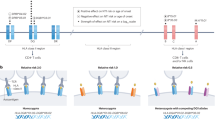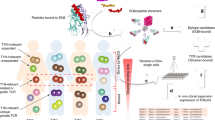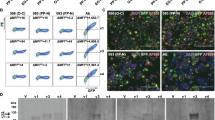Abstract
Narcolepsy is a chronic sleep disorder caused by the loss of neurons that produce hypocretin. The close association with HLA-DQB1*06:02, evidence for immune dysregulation and increased incidence upon influenza vaccination together suggest that this disorder has an autoimmune origin. However, there is little evidence of autoreactive lymphocytes in patients with narcolepsy. Here we used sensitive cellular screens and detected hypocretin-specific CD4+ T cells in all 19 patients that we tested; T cells specific for tribbles homologue 2—another self-antigen of hypocretin neurons—were found in 8 out of 13 patients. Autoreactive CD4+ T cells were polyclonal, targeted multiple epitopes, were restricted primarily by HLA-DR and did not cross-react with influenza antigens. Hypocretin-specific CD8+ T cells were also detected in the blood and cerebrospinal fluid of several patients with narcolepsy. Autoreactive clonotypes were serially detected in the blood of the same—and even of different—patients, but not in healthy control individuals. These findings solidify the autoimmune aetiology of narcolepsy and provide a basis for rapid diagnosis and treatment of this disease.
This is a preview of subscription content, access via your institution
Access options
Access Nature and 54 other Nature Portfolio journals
Get Nature+, our best-value online-access subscription
$29.99 / 30 days
cancel any time
Subscribe to this journal
Receive 51 print issues and online access
$199.00 per year
only $3.90 per issue
Buy this article
- Purchase on Springer Link
- Instant access to full article PDF
Prices may be subject to local taxes which are calculated during checkout




Similar content being viewed by others
Data availability
The data presented in this manuscript are included in the paper and its Supplementary Information. TCR sequences from samples listed in Supplementary Table 2 are available as a .txt file. The sequences have also been deposited in the ImmunoAccess database (http://clients.adaptivebiotech.com/pub/Latorre-2018-nature; https://www.doi.org/10.21417/B73H0P).
References
Dauvilliers, Y., Arnulf, I. & Mignot, E. Narcolepsy with cataplexy. Lancet 369, 499–511 (2007).
Scammell, T. E. Narcolepsy. N. Engl. J. Med. 373, 2654–2662 (2015).
Peyron, C. et al. A mutation in a case of early onset narcolepsy and a generalized absence of hypocretin peptides in human narcoleptic brains. Nat. Med. 6, 991–997 (2000).
Thannickal, T. C. et al. Reduced number of hypocretin neurons in human narcolepsy. Neuron 27, 469–474 (2000).
Mignot, E., Hayduk, R., Black, J., Grumet, F. C. & Guilleminault, C. HLA DQB1*0602 is associated with cataplexy in 509 narcoleptic patients. Sleep 20, 1012–1020 (1997).
Tafti, M. et al. DQB1 locus alone explains most of the risk and protection in narcolepsy with cataplexy in Europe. Sleep 37, 19–25 (2014).
Hartmann, F. J. et al. High-dimensional single-cell analysis reveals the immune signature of narcolepsy. J. Exp. Med. 213, 2621–2633 (2016).
Lecendreux, M. et al. Narcolepsy type 1 is associated with a systemic increase and activation of regulatory T cells and with a systemic activation of global T cells. PLoS ONE 12, e0169836 (2017).
Partinen, M. et al. Narcolepsy as an autoimmune disease: the role of H1N1 infection and vaccination. Lancet Neurol. 13, 600–613 (2014).
Dauvilliers, Y. et al. Increased risk of narcolepsy in children and adults after pandemic H1N1 vaccination in France. Brain 136, 2486–2496 (2013).
Dauvilliers, Y. et al. Hypothalamic immunopathology in anti-Ma-associated diencephalitis with narcolepsy–cataplexy. JAMA Neurol. 70, 1305–1310 (2013).
Bernard-Valnet, R. et al. CD8 T cell-mediated killing of orexinergic neurons induces a narcolepsy-like phenotype in mice. Proc. Natl Acad. Sci. USA 113, 10956–10961 (2016).
Ramberger, M. et al. CD4+ T-cell reactivity to orexin/hypocretin in patients with narcolepsy type 1. Sleep 40, zsw070 (2017).
Kornum, B. R. et al. Absence of autoreactive CD4+ T-cells targeting HLA-DQA1*01:02/DQB1*06:02 restricted hypocretin/orexin epitopes in narcolepsy type 1 when detected by EliSpot. J. Neuroimmunol. 309, 7–11 (2017).
Sakurai, T. et al. Orexins and orexin receptors: a family of hypothalamic neuropeptides and G protein-coupled receptors that regulate feeding behavior. Cell 92, 573–585 (1998).
Geiger, R., Duhen, T., Lanzavecchia, A. & Sallusto, F. Human naive and memory CD4+ T cell repertoires specific for naturally processed antigens analyzed using libraries of amplified T cells. J. Exp. Med. 206, 1525–1534 (2009).
Sallusto, F. et al. T-cell trafficking in the central nervous system. Immunol. Rev. 248, 216–227 (2012).
Cvetkovic-Lopes, V. et al. Elevated tribbles homolog 2-specific antibody levels in narcolepsy patients. J. Clin. Invest. 120, 713–719 (2010).
Toyoda, H. et al. Anti-tribbles homolog 2 autoantibodies in Japanese patients with narcolepsy. Sleep 33, 875–878 (2010).
Kawashima, M. et al. Anti-tribbles homolog 2 (TRIB2) autoantibodies in narcolepsy are associated with recent onset of cataplexy. Sleep 33, 869–874 (2010).
Ahmed, S. S. et al. Antibodies to influenza nucleoprotein cross-react with human hypocretin receptor 2. Sci. Transl. Med. 7, 294ra105 (2015).
Hallmayer, J. et al. Narcolepsy is strongly associated with the T-cell receptor alpha locus. Nat. Genet. 41, 708–711 (2009).
Faraco, J. et al. ImmunoChip study implicates antigen presentation to T cells in narcolepsy. PLoS Genet. 9, e1003270 (2013).
Mohan, J. F. & Unanue, E. R. Unconventional recognition of peptides by T cells and the implications for autoimmunity. Nat. Rev. Immunol. 12, 721–728 (2012).
Sadegh-Nasseri, S. & Kim, A. MHC class II auto-antigen presentation is unconventional. Front. Immunol. 6, 372 (2015).
Morrish, E., King, M. A., Smith, I. E. & Shneerson, J. M. Factors associated with a delay in the diagnosis of narcolepsy. Sleep Med. 5, 37–41 (2004).
Andlauer, O. et al. Predictors of hypocretin (orexin) deficiency in narcolepsy without cataplexy. Sleep 35, 1247–1255 (2012).
Thannickal, T. C., Nienhuis, R. & Siegel, J. M. Localized loss of hypocretin (orexin) cells in narcolepsy without cataplexy. Sleep 32, 993–998 (2009).
Baumann, C. R. et al. Challenges in diagnosing narcolepsy without cataplexy: a consensus statement. Sleep 37, 1035–1042 (2014).
Iijima, N. & Iwasaki, A. Access of protective antiviral antibody to neuronal tissues requires CD4 T-cell help. Nature 533, 552–556 (2016).
Mohan, J. F., Petzold, S. J. & Unanue, E. R. Register shifting of an insulin peptide–MHC complex allows diabetogenic T cells to escape thymic deletion. J. Exp. Med. 208, 2375–2383 (2011).
Kent, S. C. et al. Expanded T cells from pancreatic lymph nodes of type 1 diabetic subjects recognize an insulin epitope. Nature 435, 224–228 (2005).
Pathiraja, V. et al. Proinsulin-specific, HLA-DQ8, and HLA-DQ8-transdimer-restricted CD4+ T cells infiltrate islets in type 1 diabetes. Diabetes 64, 172–182 (2015).
Babon, J. A. et al. Analysis of self-antigen specificity of islet-infiltrating T cells from human donors with type 1 diabetes. Nat. Med. 22, 1482–1487 (2016).
Barateau, L., Liblau, R., Peyron, C. & Dauvilliers, Y. Narcolepsy type 1 as an autoimmune disorder: evidence, and implications for pharmacological treatment. CNS Drugs 31, 821–834 (2017).
Zand, M. S. et al. A renewable source of donor cells for repetitive monitoring of T- and B-cell alloreactivity. Am. J. Transplant. 5, 76–86 (2005).
Lindestam Arlehamn, C. S. et al. Memory T cells in latent Mycobacterium tuberculosis infection are directed against three antigenic islands and largely contained in a CXCR3+CCR6+ TH1 subset. PLoS Pathog. 9, e1003130 (2013).
Campion, S. L. et al. Proteome-wide analysis of HIV-specific naive and memory CD4+ T cells in unexposed blood donors. J. Exp. Med. 211, 1273–1280 (2014).
Messi, M. et al. Memory and flexibility of cytokine gene expression as separable properties of human TH1 and TH2 lymphocytes. Nat. Immunol. 4, 78–86 (2003).
Becattini, S. et al. Functional heterogeneity of human memory CD4+ T cell clones primed by pathogens or vaccines. Science 347, 400–406 (2015).
Acknowledgements
We thank all patients and their families for their participation in the study. We thank A. Sette and C. Lindestam Arlehamn (La Jolla Institute for Allergy and Immunology) for providing the human cytomegalovirus and Epstein–Barr virus peptide pools, G. Nepom and W. Kwok (University of Washington) and R. Martin and M. Sospedra (University Hospital Zurich) for providing DR2a- and DR2b-transfected B cell lines, the Servizio Tipizzazione of the Policlinico San Matteo, University of Pavia, for HLA typing, H. Hidalgo for logistical support and L. Sallusto for discussions and support. This work was supported by the European Research Council grant (no. 323183, PREDICT, to F.S.) and the Swiss National Science Foundation grants (no. 149475 and no. CRSII3_154483 to F.S.). F.S. and the Institute for Research in Biomedicine are supported by the Helmut Horten Foundation.
Reviewer information
Nature thanks B. Kornum, E. Unanue and the other anonymous reviewer(s) for their contribution to the peer review of this work.
Author information
Authors and Affiliations
Contributions
D.L. performed experiments with assistance from E.A., F.M., A.C. and S.J. U.K., J.M., F.Z., R.K., M.M. and C.L.B. recruited participants, performed clinical evaluation and collected biological samples. D.J. performed cell sorting. M.F. performed bioinformatics analysis. M.T. supervised HLA typing. F.S. and C.L.B. conceived and supervised the project. F.S., D.L., C.L.B., U.K., M.T., B.B. and A.L. wrote the manuscript. All authors provided input and reviewed the manuscript.
Corresponding authors
Ethics declarations
Competing interests
The authors declare no competing interests.
Additional information
Publisher’s note: Springer Nature remains neutral with regard to jurisdictional claims in published maps and institutional affiliations.
Extended data figures and tables
Extended Data Fig. 1 Screening of memory CD4+ T cell library from patients with NT1 or NT2 and healthy controls.
a–c, Memory CD4+ T cell screening for Influvac. Memory CD4+ T cell libraries from patients with NT1 or NT2 and control donors shown in Fig. 2 were also screened for their capacity to proliferate in response to the influenza vaccine Influvac, used as a positive control. On day 4, proliferation was measured after a 16-h pulse with [3H]thymidine. The number of tested T cell lines per donor is indicated on top of the graphs and the proliferation of individual T cell lines (each line is represented by a single dot) is shown as Δc.p.m. value. Positive lines were defined as Δc.p.m. ≥ 2,000 (horizontal dotted line) and SI ≥ 3. d, The frequency of Influvac-specific memory CD4+ T cells in patients with narcolepsy and controls (NT1, n = 13; NT2, n = 3; control, n = 12, biologically independent samples) is shown. Dots represent frequency in each donor, boxes are quartile values, whiskers represent the highest and lowest values, and lines represent the median values. Results are presented as precursor frequency per million memory CD4+ T cells. Data were analysed using two-tailed Mann–Whitney U-test. NS, not significant (P values > 0.05).
Extended Data Fig. 2 Autoreactive memory CD8+ T cells in patients with NT1 or NT2 as detected using the T cell library method.
a–c, f–h, Memory CD8+ T cells were polyclonally expanded and screened for their capacity to proliferate in response to HCRT peptide pool (a–c) or CMV + EBV peptide pool (f–h), used as positive control, in the presence of irradiated autologous B cells. On day 4, proliferation was measured after a 16-h pulse with [3H]thymidine. The number of tested T cell lines per donor is indicated on top of the graphs and the proliferation of individual T cell lines (each represented by a single dot) is shown as Δc.p.m. value. Positive responses were defined as Δc.p.m. ≥ 2,000 (horizontal dotted line) and SI ≥ 3. d, The Δc.p.m. values of HCRT-positive T cell lines (NT1, n = 6; NT2, n = 20; control, n = 2, biologically independent samples) from patients (PT) and controls (C) are shown. e, i, The frequency of HCRT-specific (e) and CMV + EBV-specific (i) cells per million memory CD8+ T cells in patients with narcolepsy and controls is shown (e, NT1, n = 10; NT2, n = 3; control, n = 9, biologically independent samples; i, NT1, n = 10; NT2, n = 2; control, n = 9, biologically independent samples). Dots represent frequency in each donor, boxes are quartile values, whiskers represent the highest and lowest values, and lines represent the median values. Results are presented as precursor frequency per million memory CD8+ T cells. Data were analysed using two-tailed Mann–Whitney U-test. NS, not significant (P values > 0.05).
Extended Data Fig. 3 Cytokine production and gene expression by autoreactive CD4+ T cell clones from patients with narcolepsy.
a, b, HCRT-specific (a, n = 26 biologically independent samples) and TRIB2-specific (b, n = 18 biologically independent samples) CD4+ T cell clones derived from patients with narcolepsy were stimulated with HCRT peptide pool (a) or TRIB2 peptide pool (b) presented by irradiated autologous B cells. Cytokines released in the 48-h culture supernatants were quantified by bead-based multiplex assay. Data represent the mean + s.e.m. c, d, mRNA expression levels for 579 genes in HCRT-specific (c, n = 6 biologically independent samples; n = 3 from P1 and n = 3 from P8) and TRIB2-specific (d, n = 6 biologically independent samples; n = 4 from P22 and n = 2 from P14) CD4+ T cell clones were measured using NanoString technology. The top 50 expressed genes are shown. Data represent the mean ± s.e.m.
Extended Data Fig. 4 Evaluation of T cell cross-reactivity with influenza virus antigens and MHC restriction of autoreactive T cell clones.
a, b, HCRT-specific (a, n = 61 biologically independent samples) and TRIB2-specific (b, n = 14 biologically independent samples) CD4+ T cell clones from patients with narcolepsy were stimulated in the presence of irradiated autologous B cells pulsed with HCRT peptide pool, TRIB2 peptide pool or influenza vaccine (Influvac) and—for some clones (n = 29, HCRT-specific and n = 9, TRIB2-specific)—with haemagglutinnin (HA) peptide pool. Each clone represents an individual clonotype. The c.p.m. values indicate the proliferation of autoreactive T cell clones measured after a 16-h pulse with [3H]thymidine are shown. c, The proliferative response of HCRT-specific, HLA-DR-restricted CD4+ T cell clones (n = 9 biologically independent samples) after stimulation with irradiated autologous B cells or a DRB1*15:01-transfected B cell line in absence or presence of HCRT peptide pool, is shown. Proliferation was measured on day 3 after a 16-h pulse with [3H]thymidine.
Extended Data Fig. 5 Clonotypic analysis of blood memory CD4+ T cells.
a, b, TCR Vβ sequencing was performed on memory CD4+ T cells ex vivo after sorting from peripheral blood of the indicated patients with narcolepsy (a) and healthy controls (b). The frequency distribution of all TCR Vβ clonotypes (n indicates total number of clonotypes) is shown. In these samples, no sequences of autoreactive T cell clones were found. The number of sequenced clonotypes was comparable in patients and controls; a range of 14,812–58,900 (39,494 ± 10,514 (mean ± s.d.)) and a range of 18,731–44,004 (33,354 ± 7,831 (mean ± s.d.)), respectively. TCR sequencing data are available as Supplementary Information.
Extended Data Fig. 6 Clonotype sharing of blood and CSF CD4+ and CD8+ T cells from patients with narcolepsy.
a, TCR Vβ sequencing was performed on memory CD4+ T cells ex vivo after sorting from blood, and on CD4+ T cells sorted from in vitro-expanded CSF T cells. The comparison of clonotype frequency distribution of CD4+ T cells from CSF (y axis) and blood (x axis) from the same patient is shown. Coloured circles represent autoreactive clonotypes (red, HCRT-specific; green, TRIB2-specific). b, TCR Vβ sequencing was performed on memory CD8+ T cells ex vivo after sorting from blood, and on CD8+ T cells sorted from in vitro-expanded CSF T cells. The comparison of clonotype frequency distribution of CD8+ T cells from CSF (y axis) and blood (x axis) from the same patient is shown. The total number of clonotypes in each sample is indicated on the axis. Values on top of the plots represent the number and the percentage of shared clonotypes between the two samples, calculated on the total number of clonotypes found in the CSF. TCR sequencing data are available as Supplementary Information.
Supplementary information
Supplementary Tables
This file contains Supplementary Tables 1-3.
Supplementary Data
This file contains TCR sequencing data.
Rights and permissions
About this article
Cite this article
Latorre, D., Kallweit, U., Armentani, E. et al. T cells in patients with narcolepsy target self-antigens of hypocretin neurons. Nature 562, 63–68 (2018). https://doi.org/10.1038/s41586-018-0540-1
Received:
Accepted:
Published:
Issue Date:
DOI: https://doi.org/10.1038/s41586-018-0540-1
Keywords
This article is cited by
-
Autoreactive T cells target peripheral nerves in Guillain–Barré syndrome
Nature (2024)
-
The immunopathogenesis of narcolepsy type 1
Nature Reviews Immunology (2024)
-
Narcolepsy type I-associated DNA methylation and gene expression changes in the human leukocyte antigen region
Scientific Reports (2023)
-
I-Ag7 β56/57 polymorphisms regulate non-cognate negative selection to CD4+ T cell orchestrators of type 1 diabetes
Nature Immunology (2023)
-
Origins and immunopathogenesis of autoimmune central nervous system disorders
Nature Reviews Neurology (2023)
Comments
By submitting a comment you agree to abide by our Terms and Community Guidelines. If you find something abusive or that does not comply with our terms or guidelines please flag it as inappropriate.



